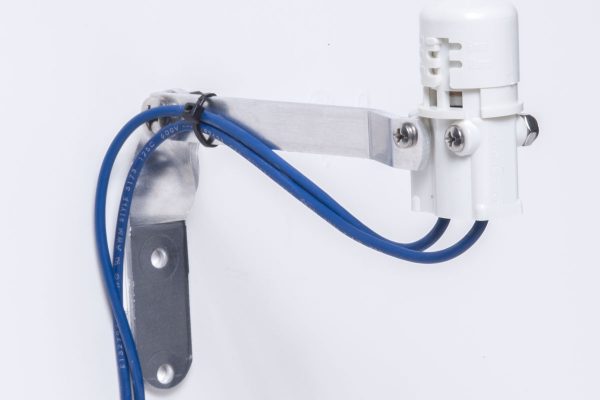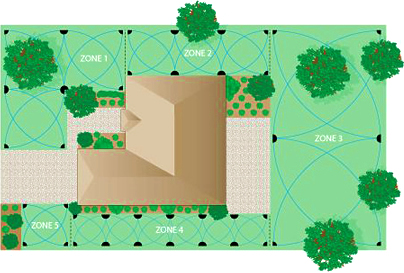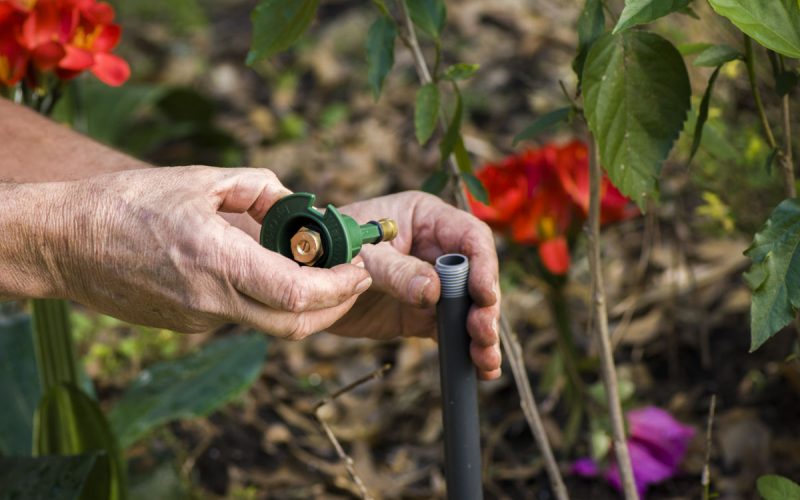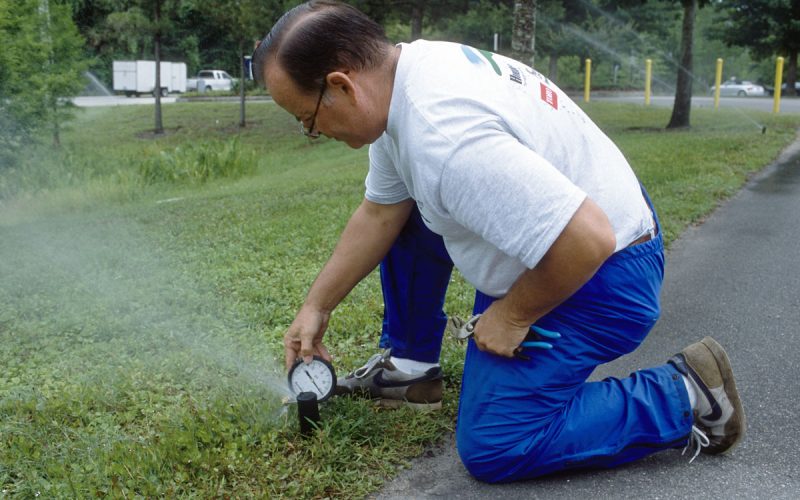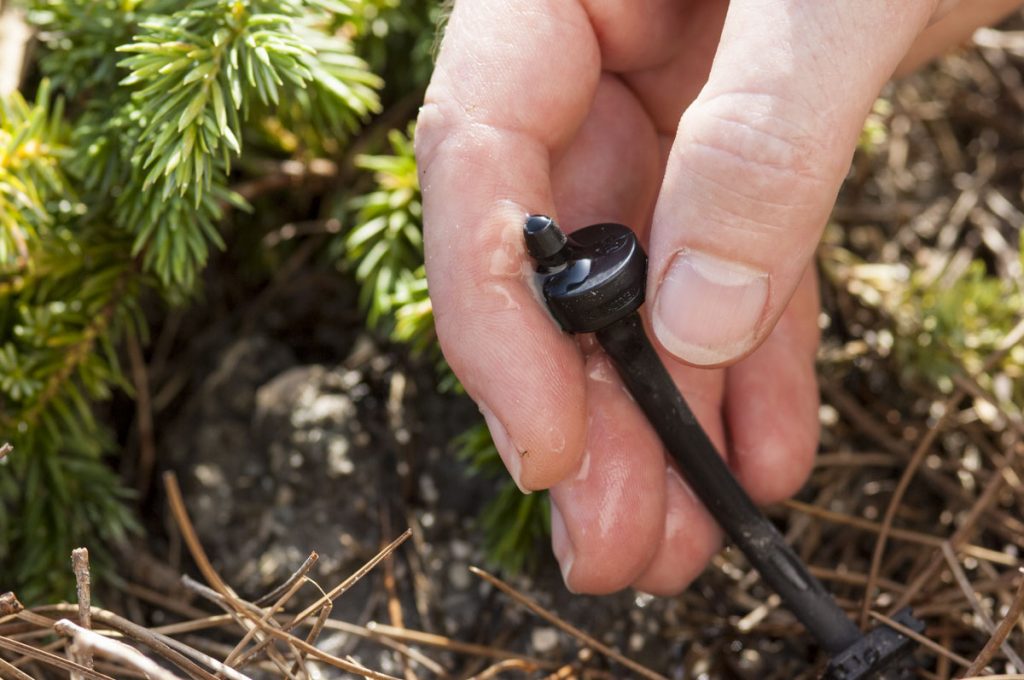Irrigation hours
Water lawns during the early morning or early evening hours — before 10 a.m. or after 4 p.m. — when temperature and wind speed are lowest. This reduces losses from evaporation and wind that can occur during the middle of the day. This also allows the water to seep into the ground to the grass and plant roots, promoting healthier plants with deep root systems.
The watering restrictions allow watering only before 10 a.m. or after 4 p.m., with a few exceptions.
Learn more about the watering restrictions.
Irrigation checkup video
Video shows easy ways to ensure your automatic irrigation system functions properly and follows watering restrictions.
Irrigation amounts
Apply moderate amounts of water to create a healthy, drought- and stress-tolerant lawn. For most Florida soils, applying no more than three-quarters of an inch of water per application is enough to revitalize the grass. Saturate the root zone, then let soil dry to encourage healthy, deep root growth. Overwatering promotes weed growth, disease and fungus.
You can use the “catch” can method to determine how much water to apply and to see if you are watering uniformly across the landscaped area. Place five to seven wide-mouthed, flat-bottom cans (cans about the size of an average tuna can) throughout the zones to be irrigated. Irrigate each zone as you normally would. When you have finished irrigating a zone, measure the depth of water in each can. Average the measurements and use this number to determine how long you need to water to apply three-quarters of an inch of water in each irrigation zone.
While testing your system using the “catch” can method is the most effective way to determine how much water you are applying, there are some general guidelines for inground systems. These guidelines are based on the type of head used in each irrigation zone. Landscape beds usually need less water than grass, often half the amount. A well-established shrub bed may not need any additional water other than rainfall and it may be possible to cap the irrigation heads in these areas.
A tip for knowing how much water your sprinkler distributes
Take control of your sprinkler system to ensure you’re following watering restrictions and not overwatering. Use the easy “catch can” method to determine how much water your sprinkler system puts out.
Schedule for efficiency
| Head type | Setting | Summer | Fall | Winter | Spring |
|---|---|---|---|---|---|
| Spray | Ideal | 25 min | 15 min | 0 min | 20 min |
| Range | 20-30 min | 10-20 min | 0-10 min | 15-20 min | |
| Rotor and rotary nozzle | Ideal | 45 min | 30 min | < 10 min | 40 min |
| Range | 40-60 min | 20-40 min | 0-20 min | 35-55 min |
Irrigation system maintenance
We can have a tremendous impact on the amount of water we use outdoors by using well-designed irrigation systems and performing regular maintenance to keep them functioning properly.
An automatic irrigation system is set for a predetermined time of day and days of the week. Make sure it is set to follow the watering restrictions. Learn how to operate your system. Check timing devices regularly to make sure they are operating properly. Watch for broken or misdirected sprinklers. During extended periods of rainy weather, irrigation systems should be turned off.
Install sprinklers that are the most water efficient for each use. Rotors and spray heads are good for turf areas, but don’t use both in the same zone. For even distribution, flow rates must be consistent throughout the zone. In planting beds, use micro-irrigation, which includes drip and soaker hoses. Also, use spray heads designed for planting beds. Position the sprinkler to water only the lawn and shrubs, not paved areas.
Maintain your irrigation system. Watch for broken or misdirected sprinklers. Check for leaks and clogged spray heads. Soft, wet spots around the sprinkler could indicate a leak is being absorbed into the ground.
Florida law requires that all automatic irrigation systems installed after May 1991 have a functioning rain sensor shut-off switch. This switch overrides the automatic irrigation system’s cycle when a preset amount of rain has fallen. The switch can be adjusted for different amounts of rainfall. To ensure proper functioning, the sensor should not be installed in an area that is blocked by roof overhangs, bushes or trees. Check regularly to make sure the system is working properly.
Backflow prevention devices are also necessary to prevent water from flowing back into the water main, which can contaminate drinking water.
With Florida’s irrigation laws continually being updated, you should consult with or hire a certified professional to design and install an irrigation system. Certified professionals can be found by contacting organizations such as:
General design tips
A landscape and an irrigation system should be designed so that they work well together. This means putting your plants in “irrigation zones,” allowing for a system design that will deliver the appropriate amount of water to individual planting beds or turf areas. This will help reduce irrigated turf areas and increase landscaped beds.
Irrigation zones
For efficient irrigation, zones are critical. Each irrigation zone should be composed of the same kind of emitters throughout, be it rotors, spray heads or micro-irrigation. The rate at which different heads deliver water varies, so for even coverage, head types should not be mixed. Also, heads from different manufacturers vary in coverage, so all heads should be the same brand to ensure even coverage.
The term “head-to-head coverage” is used to describe proper placement of sprinkler heads to ensure even water coverage. Essentially, the water from one head should reach the closest neighboring heads.
Use rotors or pop-up spray heads for turf areas, but don’t use both in the same zone.
Other considerations include:
- Use rotors to water large turf areas.
- Use spray heads to water medium- to small-sized turf areas.
- Use micro-irrigation to water planting beds. Because it is a low-volume irrigation technique, micro-irrigation uses less water than rotors and spray heads. Micro-irrigation systems include trickle or drip, micro-sprays (also known as micro-jets) and bubblers.
- Use bubblers to establish trees or large shrubs.
Head placement
Spray head placement is just as important as the type of head used in the various zones of your irrigation system.
Spray heads should rise above properly mowed St. Augustine turf. Use six-inch pop-up riser extensions and periodically raise spray heads above grass beds.
Pressures and piping
Adequate pressure must be factored through the entire system, from the water source to the last head on the line. Increases in pressure can occur by improper design, such as by using pipe that is too small. Too much pressure in pipes can cause leaks by wearing down pipes and fittings.
Low pressure is apparent when heads emit large droplets, which can cause erosion and runoff. Too much pressure can result in heads misting, allowing water to drift away. Pressure-regulated heads or valves can reduce high pressure issues.
Irrigation controller
Most irrigation system timers, also known as controllers, allow a great level of control over watering schedules but can also be responsible for a lot of waste if not programmed correctly. Familiarize yourself with your timer’s functions using the instruction manual it came with. Often, controllers also have directions on the inside of the cover panel or online videos to explain their functioning.
Program elements
Timers generally have three criteria that need to be set: watering days, start time and watering duration.
What days the system waters will need to be changed seasonally.
“Start times” refer to the time of day the first zone will begin watering, followed by the other zones in sequence. Remember to set your system to operate before 10 a.m. or after 4 p.m.
Watering duration
The number of minutes that each zone runs — depends on the type of head used in each zone. Three-quarters of an inch of water is enough to replenish the grass.
Moderate amounts of water can create a healthy, drought- and stress-tolerant lawn. Applying no more than three-quarters of an inch of water is enough to replenish the grass.
Schedule for efficiency
| Head type | Setting | Summer | Fall | Winter | Spring |
|---|---|---|---|---|---|
| Spray | Ideal | 25 min | 15 min | 0 min | 20 min |
| Range | 20-30 min | 10-20 min | 0-10 min | 15-20 min | |
| Rotor and rotary nozzle | Ideal | 45 min | 30 min | < 10 min | 40 min |
| Range | 40-60 min | 20-40 min | 0-20 min | 35-55 min |
Other considerations
The following factors should also be considered when scheduling irrigation systems:
- During extended periods of rainy weather, irrigation systems should be turned off.
- Irrigation controllers have default programs that take over if a set program is lost due to a power outage. On some controllers if the schedule switch is in the “custom” mode, it will default to watering every day. Reset program after a power outage.
For an irrigation system to function efficiently, regular maintenance is required. Just as you routinely rotate the tires and change the oil of your car, you must also inspect and adjust your irrigation system for it to work properly. You should:
- Turn the system on occasionally during daylight hours to observe the heads during irrigation and to check for broken or misdirected spray heads.
- Periodically raise rotors and spray heads above grass beds because foot and mower traffic tend to push them into the soil.
- Buy and install riser extensions as ground covers grow or grass thickens at the base. These keep spray heads above grass beds.
- Replace or clean micro-spray heads if they are clogged.
- Adjust heads so they cover the target area and don’t waste water on tree trunks or sidewalks.
- Clean micro-irrigation filters as needed. Filtration is necessary to prevent spray emitters from getting clogged.
- Use only replacement parts produced by the same manufacturer, as different brands often don’t match up correctly.
“Smart” irrigation controllers
“Smart” water application technologies take the human element out of the equation. Smart sensors and controllers monitor weather and other site conditions and adjust the irrigation system to apply just the right amount of water at just the right time. Water-saving nozzles and pressure regulators apply water precisely, just where it’s needed. Together, these technologies can successfully reduce outdoor water use by as much as 20 to 40 percent annually, while maintaining a healthy, beautiful landscape. Many of these devices have WiFi functionality and can be controlled from a smart phone. Learn more about the different types of smart controllers and devices, in the following information shared from the Irrigation Association.
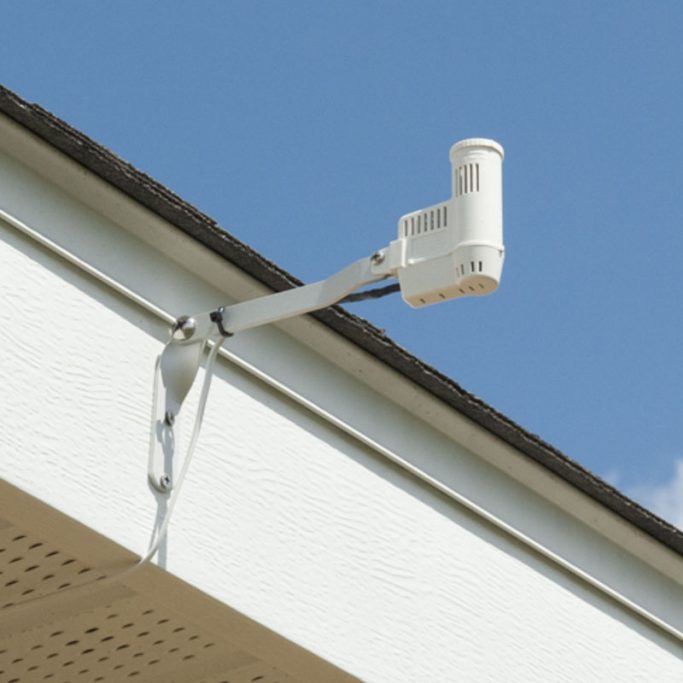
Rain sensors
Rain sensors prevent a sprinkler system from running during a rainstorm. These devices are designed to temporarily shut off an irrigation system, so it stops running when it detects rain. Rain sensors can be retrofitted on installed sprinkler systems. You may also see them referred to as rain shut-off devices or rain switches. Rain sensors are required on all new homes in Florida.
The most common rain sensor models include an absorbent disk that swells when it gets wet, triggering an electrical switch that overrides the irrigation system. The disk shrinks as it dries out, allowing the system to operate normally. Other models weigh the amount of water collected or use a set of probes to detect the water level. Rain sensors should be checked annually to be sure they are functioning properly.
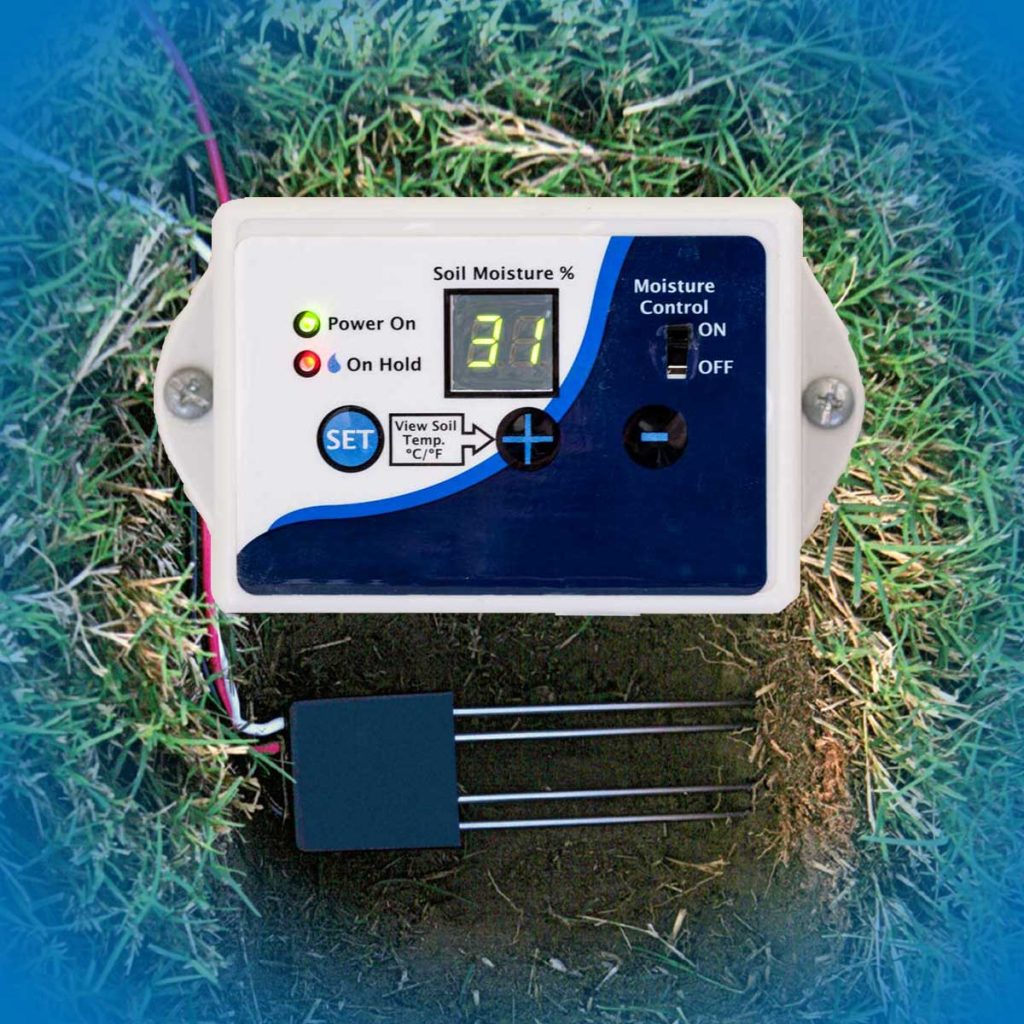
Soil moisture-based controllers
It can sometimes be difficult to determine whether your plants are being watered properly. Thanks to soil moisture-based controllers, you can ensure that they receive just the right amount of water for their conditions. A soil moisture-based controller shuts off an irrigation system when the ground is already wet, preventing overwatering. The controller turns the system back on when the soil becomes drier.
These smart controllers use probes to measure moisture at the root zone. The system compares this reading to the recommended moisture level for the plant, soil type and other variables that were programmed when the controller was first installed.
If the amount of moisture in the soil meets or exceeds the target level, the controller turns off the irrigation system. When the sensor detects dry conditions, it allows the system to operate as programmed. Soil moisture-based controllers can be retrofitted on installed irrigation systems. Many manufacturers also make soil moisture sensors that can retrofit to existing systems and interface with the current controller already on-site.
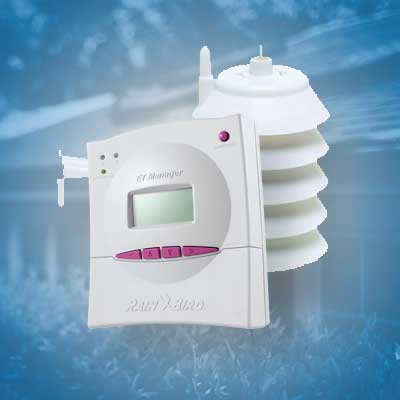
Weather-based controllers
A weather-based controller monitors changing weather conditions and waters accordingly. These products are also referred to as climate-based controllers, climatologically based controllers and smart controllers. They use weather data to calculate evapotranspiration, the amount of water that evaporates from the soil surface or is used by the plant. Based on local weather conditions, these smart controllers automatically adjust the irrigation schedule to deliver only enough water to meet the plant needs.
Different controllers use different sources of weather data. These include on-site weather sensors, data from a local weather station or data from the internet. Weather-based controllers can be retrofitted on new or existing irrigation systems.
Micro-irrigation, the basics
Micro-irrigation, commonly referred to as “drip” or “low-volume” irrigation, offers a way to improve landscape quality while saving water. When designed and used correctly, this approach can improve the efficiency of landscape irrigation through the precise application of water.
Micro-irrigation emitters have a maximum flow rate of 30 gallons per hour (gph), or 0.5 gallons per minute (gpm). In contrast, traditional spray and rotor sprinklers can apply water at a rate of more than 3 gpm. Micro-irrigation is commonly used for landscape bed irrigation and potted plants. Use caution with micro-irrigation on Florida lawns. More information can also be found on the Florida Water Star℠ website.
Benefits of micro-irrigation
With proper design, operation and maintenance, micro-irrigation systems can have many benefits, including:
- Decreased water loss from evaporation, wind and runoff
- Minimized pest problems, such as weeds and diseases, by applying water to the root area of the plant
- Increased water application efficiency when retrofitting in-ground sprinkler systems
- Easy connection to hoses or outdoor spigots
- Flexibility in meeting variable water needs of new, maturing and established plants
- Minimized erosion when watering plants on steep slopes
- Compliance with local water conservation codes and ordinances
Ongoing maintenance
To properly maintain the system:
- Periodically inspect plants for signs of over- or underwatering, such as wilting and/or changes in leaf color; adjust emitters or timer/controller as necessary.
- Check soil wetting patterns around individual plants to ensure that at least half of the root zone area is covered. Whole root zone coverage is preferable.
- Inspect and clean filters and emitters on a regular basis. Flush the system every two months to discharge debris.
- As plants grow, inspect emitters and move them away from the original planting area.
- Reset irrigation controller seasonally to adjust to changes in plant water needs.
- When replacing parts, use only parts specified by the equipment manufacturer.
- For more on micro-irrigation, visit the Florida Water Star℠ website
Lawn maintenance
When fertilizing, using the correct amount of fertilizer can save water and money, reduce the amount of pollutants reaching waterways, and result in a healthier landscape. Overfertilizing will aggravate pest problems, stimulate excessive plant growth, and demand frequent irrigation.
Fertilizers should be used only when specific nutrient deficiency symptoms are evident. These deficiencies can be determined by conducting a soil test or analysis. Florida-friendly lawns require only moderate amounts of supplemental fertilizer once they are established.
Avoid overuse of fertilizers, especially near the water’s edge. Rain and lawn watering can wash excess fertilizer into water bodies, where excess nutrients cause algal blooms and weed growth. The amount of fertilizer to apply depends on a number of factors, such as grass species, soil type and permeability, and your location in the state.
Apply fertilizers sparingly and follow the manufacturer’s directions on the bag, in terms of the amount per application. Know exactly the square footage of your lawn that the bag of fertilizer is intended to cover.

Florida soil is naturally high in phosphorus, and a “no phosphate” fertilizer is fine for most mature lawns. Apply a phosphate fertilizer only if a soil test demonstrates the need. For information specific to your area, contact the local County Cooperative Extension Service.
The best fertilizers for healthy landscapes and the environment are those that contain a high percentage of slow-release nitrogen. Slow-release products stay in the soil to supply nutrients to plants over a longer period of time. The product label will identify organic, slow-release or controlled release nitrogen, sulfur-coated, IBDU (15N-isobutylidene divrea), or resin-coated.
Fertilize only during the growing season, which can vary depending on where you live in Florida. Allow a month between autumn application and the first freezing temperatures, which will make new growth less vulnerable to frost.
Use pesticides, herbicides and fungicides only when needed, and apply them responsibly, following the label’s directions.
Cut your grass at the highest recommended height for your turf species or the highest setting on your lawn mower. Cut no more than one-third of the grass length at one time to encourage grass roots to grow deeper.
Keep mower blades sharp for a clean cut; dull blades tear grass, opening it to disease and increasing its need for water and fertilizer. Leave short grass clippings where they fall. The clippings reduce the lawn’s need for water and fertilizer. Remove thick patches of clippings so that the clippings will not kill the grass underneath.
Stressed lawns
While it’s important to know and follow watering restrictions, it is also critical to not water just because it’s your day. Irrigate your lawn when it shows signs of stress from lack of water.
Possible signs include:
- Grass blades are folded in half lengthwise on at least one-third of your yard.
- Grass blades appear blue-gray.
- Grass blades do not spring back, leaving footprints on the lawn for several minutes after walking on it.
To find out how much time you should spend on watering, in order to maintain a healthy lawn, please visit to: Saving water outdoors – SJRWMD
For more water-saving tips, please visit www.WaterLessFlorida.com. Join the conversation on social media using #sjrwmd #waterconservation.
Additional tips outdoors
The following are additional ways to save water and money outside your home.
- Collect water in a rain barrel to use to water your plants. Rain water is free and is better for your plants because it doesn’t contain hard minerals. Planter beds or flower gardens and potted plants can easily be irrigated with water from a rain barrel.
- Pay attention to your hose. Left unattended, a garden hose can pour out 8 to 12 gallons each minute, or hundreds of gallons of water in an hour. Check all hoses, connectors and spigots regularly to make sure they are in good working order. Use hose washers between spigots and water hoses to eliminate leaks. Replace or repair damaged or leaking hoses, nozzles, spigots and connectors.
- Use a broom to clean leaves and other debris from sidewalks and driveways rather than a hose. Using a hose to clean a driveway can waste hundreds of gallons of water.
- Outfit your hose with a spray nozzle that can be adjusted so water flows only as needed. When finished, turn it off at the faucet instead of at the nozzle to avoid leaks.
- Wash your car efficiently. Consider using a commercial car wash that recycles water. If you wash your own car, park on the grass and use a hose with a spray nozzle.
- If you install ornamental water features, such as fountains, make sure they are designed to recycle water.
- If you have a swimming pool, consider a new water-saving pool filter. Cover your spa or pool to reduce evaporation.
- Use a free app to tell you how long to run your irrigation system based on local conditions. Learn more on the University of Florida IFAS website.


